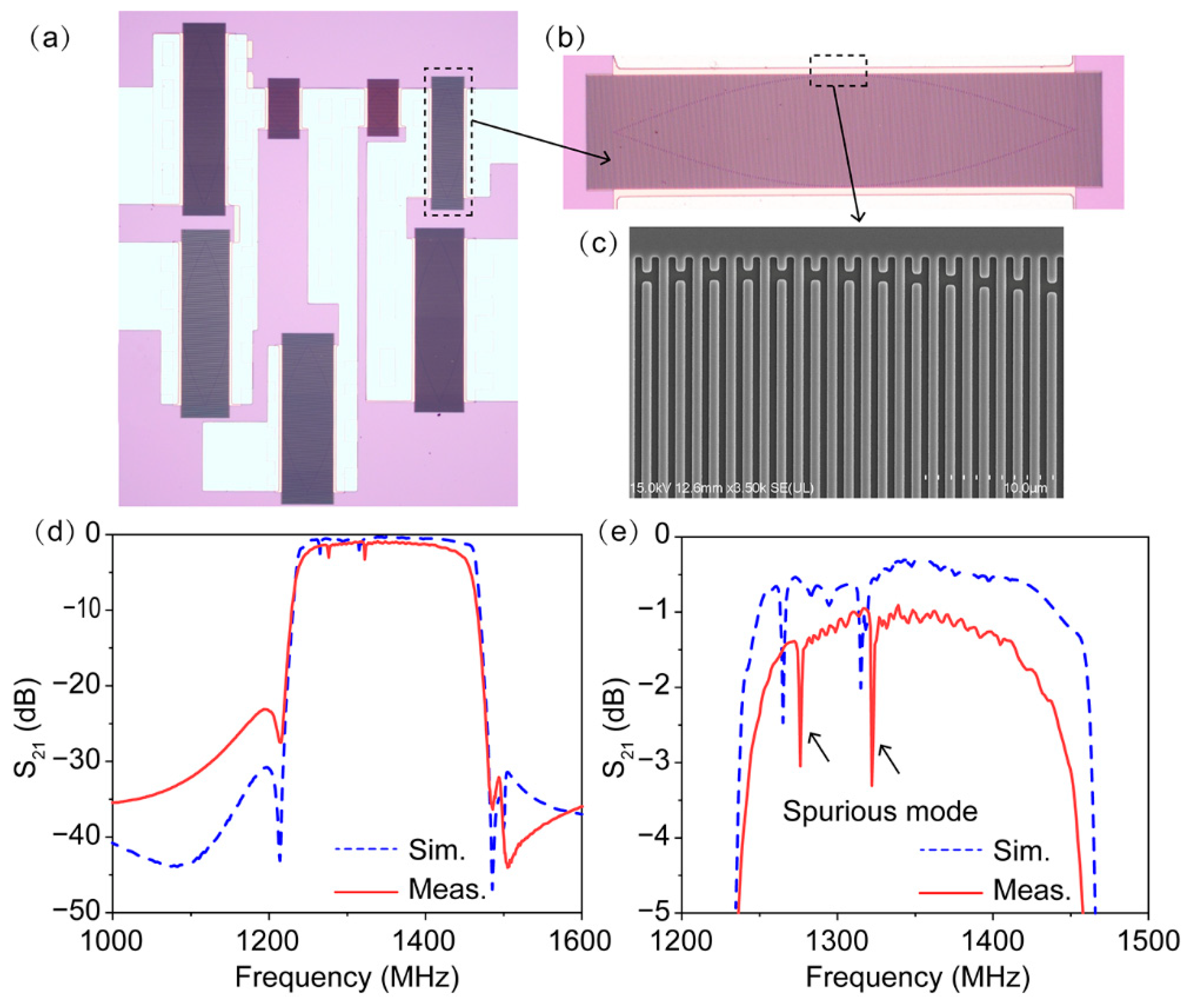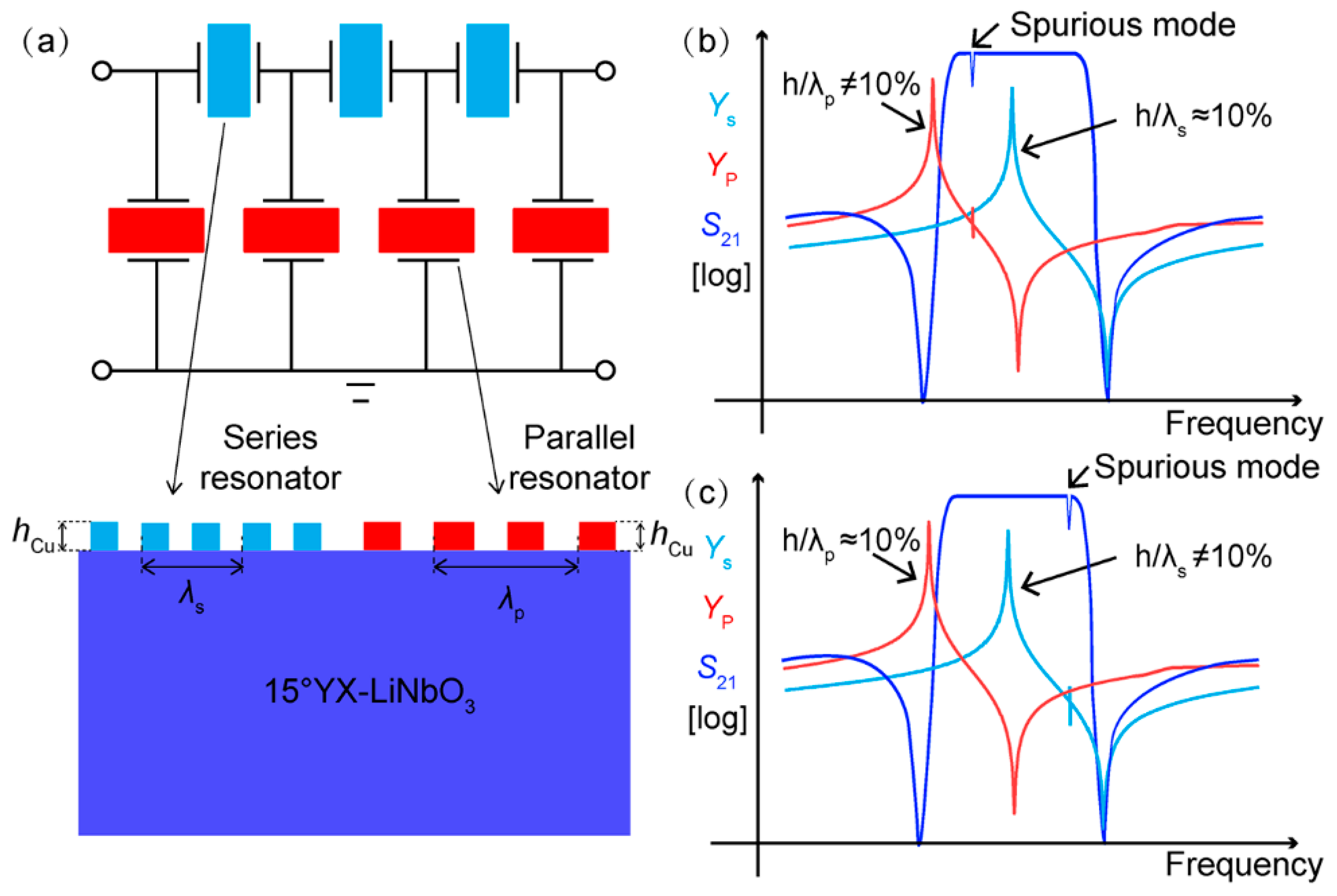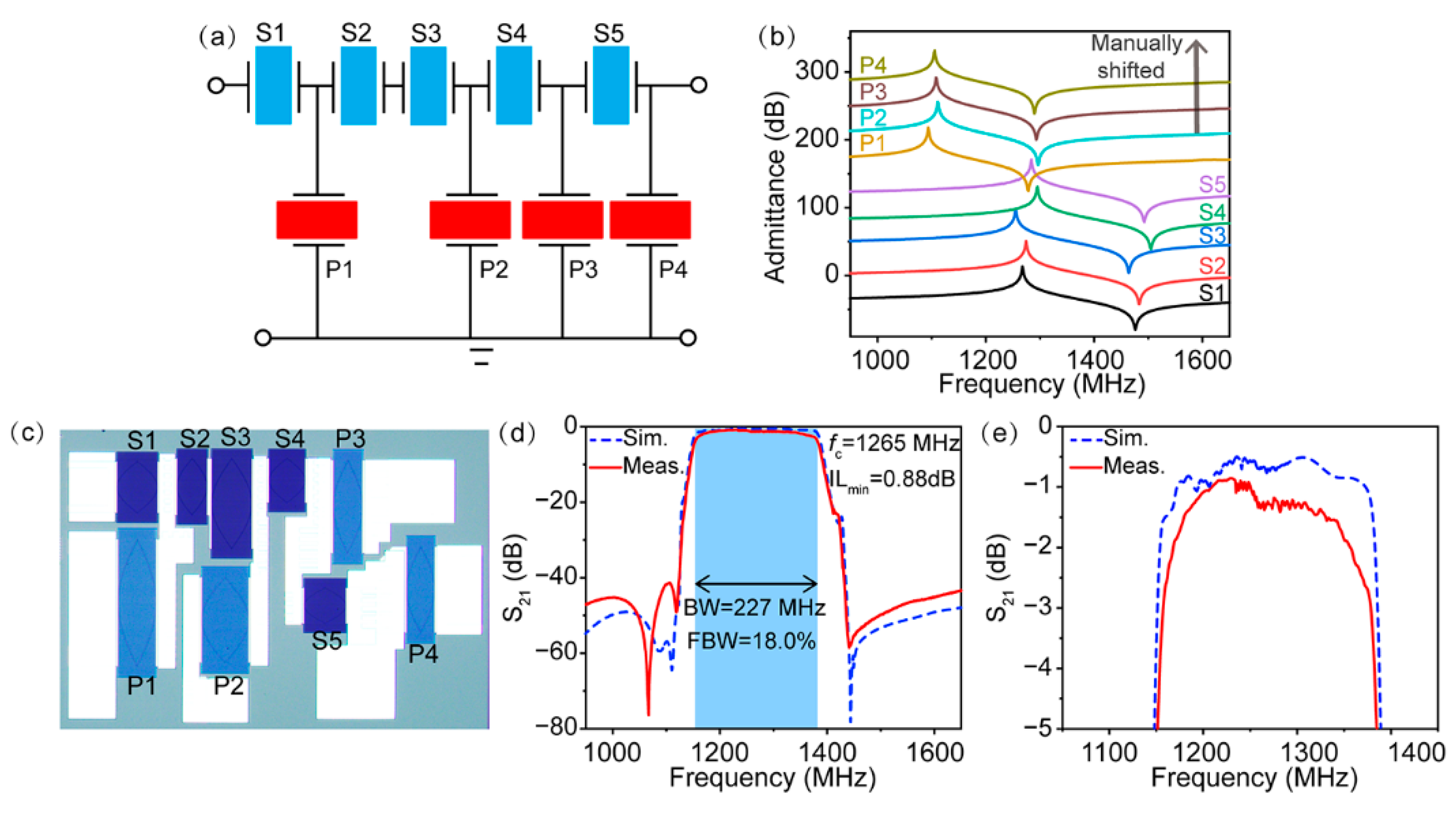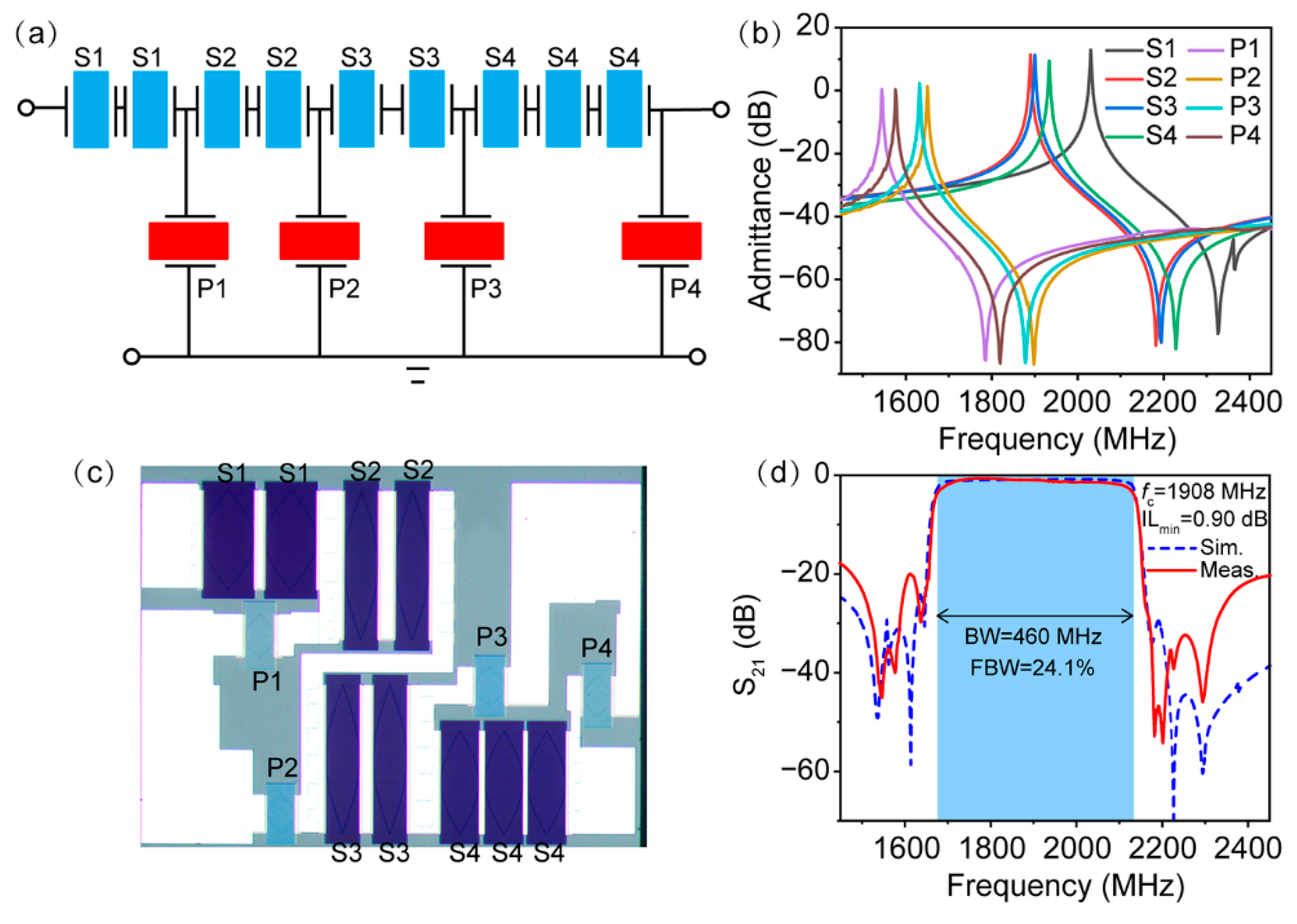Fractional Bandwidth up to 24% and Spurious Free SAW Filters on Bulk 15°YX-LiNbO3 Substrates Using Thickness-Modulated IDT Structures
Abstract
:1. Introduction
2. Materials and Methods
3. Results and Discussion
3.1. Theoretical SAW Characteristics and Traditional Filter on 15°YX-LiNbO3
3.2. Conventional Filter Configuration and Thickness-Modulated IDT Filter Configuration
3.3. Design and Fabrication of SAW Filter Using First IDT Thickness Modulated Configuration
3.4. Design and Fabrication of SAW Filter Using Second IDT Thickness Modulated Configuration
4. Conclusions
Author Contributions
Funding
Data Availability Statement
Acknowledgments
Conflicts of Interest
References
- Liu, Y.; Cai, Y.; Zhang, Y.; Tovstopyat, A.; Liu, S.; Sun, C. Materials, design, and characteristics of bulk acoustic wave resonator: A review. Micromachines 2020, 11, 630. [Google Scholar] [CrossRef] [PubMed]
- Ruby, R. A snapshot in time: The future in filters for cell phones. IEEE Microw. Mag. 2015, 16, 46–59. [Google Scholar] [CrossRef]
- Su, R.; Fu, S.; Lu, Z.; Shen, J.; Xu, H.; Mao, H.; Xu, Z.; Song, C.; Zeng, F.; Wang, W.; et al. Near 30% fractional bandwidth surface acoustic wave filters with novel electrode configuration. Prog. Nat. Sci. Mater. Int. 2021, 31, 852–857. [Google Scholar] [CrossRef]
- Tian, Y.; Wang, L.; Wang, Y.; Li, Y.; Wu, H.; Qian, L.; Li, H.; Wu, J.; Wang, J. Research in nonlinearity of surface acoustic wave devices. Micromachines 2021, 12, 1454. [Google Scholar] [CrossRef] [PubMed]
- Aubert, T.; Naumenko, N.; Bartoli, F.; Pigeat, P.; Streque, J.; Ghanbaja, J.; Elmazria, O. Non-leaky longitudinal acoustic modes in ScxAl1−xN/sapphire structure for high temperature sensor applications. Appl. Phys. Lett. 2019, 115, 083502. [Google Scholar] [CrossRef]
- Gong, S.; Lu, R.; Yang, Y.; Gao, L.; Hassanien, A.E. Microwave acoustic devices: Recent advances and outlook. IEEE J. Microw. 2021, 1, 601–609. [Google Scholar] [CrossRef]
- Yang, Y.; Gao, L.; Gong, S. X-band miniature filters using lithium niobate acoustic resonators and bandwidth widening technique. IEEE Trans. Microw. Theory Tech. 2021, 69, 1602–1610. [Google Scholar] [CrossRef]
- Zou, J.; Yantchev, V.; Iliev, F.; Plessky, V.; Samadian, S.; Hammond, R.B.; Turner, P.J. Ultra-large-coupling and spurious-free SH0 plate acoustic wave resonators based on thin LiNbO3. IEEE Trans. Ultrason. Ferroelectr. Freq. Control. 2020, 67, 374–386. [Google Scholar] [CrossRef]
- Mateu, J.; Yusuf, Y.; Perea-Robles, R.; Collado, C.; Gimenez, A.; Martin-Iglesias, P.; Aigner, R. Acoustic wave transversal filter for 5G N77 band. IEEE Trans. Microw. Theory Tech. 2021, 69, 4476–4488. [Google Scholar] [CrossRef]
- Mahon, S. The 5G effect on RF filter technologies. IEEE Trans. Semicond. Manuf. 2017, 30, 494–499. [Google Scholar] [CrossRef]
- Turner, P.J.; Garcia, B.; Yantchev, V.; Dyer, G.; Yandrapalli, S.; Villanueva, L.G.; Hammond, R.B.; Plessky, V. 5 GHz band n79 wideband microacoustic filter using thin lithium niobate membrane. Electron. Lett. 2019, 55, 942–944. [Google Scholar] [CrossRef]
- Link, A.; Warder, P. Golden age for filter design: Innovative and proven approaches for acoustic filter, duplexer, and multiplexer design. IEEE Microw. Mag. 2015, 16, 60–72. [Google Scholar]
- Takai, T.; Iwamoto, H.; Takamine, Y.; Yamazaki, H.; Fuyutsume, T.; Kyoya, H.; Nakao, T.; Kando, H.; Hiramoto, M.; Toi, T.; et al. High-performance SAW resonator on new multilayered substrate using LiTaO3 crystal. IEEE Trans. Ultrason. Ferroelectr. Freq. Control. 2017, 64, 1382–1389. [Google Scholar] [CrossRef] [PubMed]
- Zhou, H.; Zhang, S.; Li, Z.; Huang, K.; Zheng, P.; Wu, J.; Shen, C.; Zhang, L.; You, T.; Zhang, L.; et al. Surface wave and lamb wave acoustic devices on heterogenous substrate for 5G front-ends. In Proceedings of the 2020 IEEE International Electron Devices Meeting (IEDM), San Francisco, CA, USA, 12–18 December 2020; pp. 1–4. [Google Scholar]
- Yang, Y.; Lu, R.; Gao, L.; Gong, S. 4.5 GHz Lithium Niobate MEMS filters with 10% fractional bandwidth for 5G front-ends. J. Microelectromech. Syst. 2019, 28, 575–577. [Google Scholar] [CrossRef] [Green Version]
- Kadota, M.; Tanaka, S. Ultra-wideband ladder filters using zero-th shear mode plate wave in ultrathin LiNbO3 plate with apodized interdigital transducers. Jpn. J. Appl. Phys. 2016, 55, 07KD04. [Google Scholar] [CrossRef]
- Su, R.; Shen, J.; Lu, Z.; Xu, H.; Niu, Q.; Xu, Z.; Zeng, F.; Song, C.; Wang, W.; Fu, S.; et al. Wideband and low-loss surface acoustic wave filter based on 15°YX-LiNbO3/SiO2/Si structure. IEEE Electron Device Lett. 2021, 42, 438–441. [Google Scholar] [CrossRef]
- Shen, J.; Fu, S.; Su, R.; Xu, H.; Lu, Z.; Zhang, Q.; Zeng, F.; Song, C.; Wang, W.; Pan, F. Ultra-wideband surface acoustic wave filters based on the Cu/LiNbO3/SiO2/SiC structure. In Proceedings of the 2021 IEEE International Ultrasonics Symposium (IUS), Xi’an, China, 11–16 September 2021; pp. 1–4. [Google Scholar]
- Naumenko, N.; Abbott, B. Optimal cut of lithium niobate with suppressed rayleigh-type for application in resonator SAW filters. In Proceedings of the 2008 IEEE International Ultrasonics Symposium (IUS), Beijing, China, 2–5 November 2008; pp. 1013–1017. [Google Scholar]
- Hashimoto, K.Y.; Asano, H.; Matsuda, K.; Yokoyama, N.; Omori, T.; Yamaguchi, M. Wideband love wave filters operating in GHz range on Cu-grating/rotated-YX- LiNbO3-substrate structure. In Proceedings of the 2004 IEEE International Ultrasonics Symposium (IUS), Montreal, QC, Canada, 23–27 August 2004; pp. 1330–1334. [Google Scholar]
- Omori, T.; Tanaka, Y.; Hashimoto, K.; Yamaguchi, M. Synthesis of frequency response for wideband SAW ladder type filters. In Proceedings of the 2007 IEEE International Ultrasonics Symposium (IUS), New York, NY, USA, 23–27 October 2007; pp. 2574–2577. [Google Scholar]
- Omori, T.; Matsuda, K.; Sugama, Y.; Tanaka, Y.; Hashimoto, K.; Yamaguchi, M. Suppression of spurious responses for ultra-wideband and low-loss SAW ladder filter on a Cu-grating/15°YX-LiNbO3 Structure. In Proceedings of the 2006 IEEE International Ultrasonics Symposium (IUS), Vancouver, BC, Canada, 2–6 October 2006; pp. 1874–1877. [Google Scholar]
- Omori, T.; Matsuda, K.; Yokoyama, N.; Hashimoto, K.Y.; Yamaguchi, M. Suppression of transverse mode responses in ultra-wideband SAW resonators fabricated on a Cu-grating/15°YX-LiNbO3 structure. IEEE Trans. Ultrason. Ferroelectr. Freq. Control. 2007, 54, 1943–1948. [Google Scholar] [CrossRef]
- Matsuda, S.; Miura, M.; Matsuda, T.; Ueda, M.; Satoh, Y.; Hashimoto, K. Experimental studies of quality factor deterioration in shear-horizontal-type surface acoustic wave resonators caused by apodization of interdigital transducer. Jpn. J. Appl. Phys. 2011, 50, 07HD14. [Google Scholar] [CrossRef]
- Shimizu, H.; Suzuki, Y.; Kanda, T. Love-type-SAW resonator of small size with very low capacitance ratio and its application to VCO. In Proceedings of the 1990 IEEE International Ultrasonics Symposium (IUS), Honolulu, HI, USA, 4–7 December 1990; pp. 103–108. [Google Scholar]
- Zhang, Q.; Chen, Z.; Chen, Y.; Dong, J.; Tang, P.; Fu, S.; Wu, H.; Ma, J.; Zhao, X. Periodic analysis of surface acoustic wave resonator with dimensionally reduced PDE model using COMSOL code. Micromachines 2021, 12, 141. [Google Scholar] [CrossRef]
- Su, R.; Fu, S.; Shen, J.; Chen, Z.; Lu, Z.; Yang, M.; Wang, R.; Zeng, F.; Wang, W.; Song, C.; et al. Enhanced performance of ZnO/SiO2/Al2O3 surface acoustic wave devices with embedded electrodes. ACS Appl. Mater. Interfaces 2020, 12, 42378–42385. [Google Scholar] [CrossRef]
- Shen, J.; Fu, S.; Su, R.; Xu, H.; Lu, Z.; Xu, Z.; Luo, J.; Zeng, F.; Song, C.; Wang, W.; et al. High-performance surface acoustic wave devices using LiNbO3/SiO2/SiC multilayered substrates. IEEE Trans. Microw. Theory Tech. 2021, 69, 3693–3705. [Google Scholar] [CrossRef]
- Zhang, H.; Wang, H. Investigation of Surface Acoustic Wave Propagation Characteristics in New Multilayer Structure: SiO2/IDT/LiNbO3/Diamond/Si. Micromachines 2021, 12, 1286. [Google Scholar] [CrossRef] [PubMed]






| Resonator | hCu (nm) | λ (μm) | hCu/λ | Metallization Ratio | Number of IDT Electrodes | Number of Reflector |
|---|---|---|---|---|---|---|
| S1 | 220 | 2.26 | 9.73% | 0.5 | 112 | 20 |
| S2 | 2.24 | 9.82% | 0.5 | 123 | 20 | |
| S3 | 2.30 | 9.56% | 0.5 | 191 | 20 | |
| S4 | 2.19 | 10.05% | 0.5 | 99 | 20 | |
| S5 | 2.22 | 9.91% | 0.5 | 79 | 20 | |
| P1 | 255 | 2.61 | 9.77% | 0.5 | 237 | 20 |
| P2 | 2.55 | 10.00% | 0.5 | 163 | 20 | |
| P3 | 2.56 | 9.96% | 0.5 | 177 | 20 | |
| P4 | 2.57 | 9.92% | 0.5 | 163 | 20 |
| Resonator | hCu (nm) | λ (μm) | hCu/λ | Metallization Ratio | Number of IDT Electrodes | Number of Reflector |
|---|---|---|---|---|---|---|
| S1 | 140 | 1.28 | 10.93% | 0.5 | 237 | 20 |
| S2 | 1.46 | 9.56% | 0.5 | 307 | 20 | |
| S3 | 1.45 | 9.66% | 0.5 | 307 | 20 | |
| S4 | 1.41 | 9.92% | 0.5 | 223 | 20 | |
| P1 | 165 | 1.83 | 9.02% | 0.5 | 69 | 20 |
| P2 | 1.65 | 10.00% | 0.5 | 69 | 20 | |
| P3 | 1.68 | 9.82% | 0.5 | 69 | 20 | |
| P4 | 1.78 | 9.27% | 0.5 | 69 | 20 |
Publisher’s Note: MDPI stays neutral with regard to jurisdictional claims in published maps and institutional affiliations. |
© 2022 by the authors. Licensee MDPI, Basel, Switzerland. This article is an open access article distributed under the terms and conditions of the Creative Commons Attribution (CC BY) license (https://creativecommons.org/licenses/by/4.0/).
Share and Cite
Lu, Z.; Fu, S.; Xu, Z.; Wang, W.; Zhang, Q.; Zhang, J.; Zhang, H. Fractional Bandwidth up to 24% and Spurious Free SAW Filters on Bulk 15°YX-LiNbO3 Substrates Using Thickness-Modulated IDT Structures. Micromachines 2022, 13, 439. https://doi.org/10.3390/mi13030439
Lu Z, Fu S, Xu Z, Wang W, Zhang Q, Zhang J, Zhang H. Fractional Bandwidth up to 24% and Spurious Free SAW Filters on Bulk 15°YX-LiNbO3 Substrates Using Thickness-Modulated IDT Structures. Micromachines. 2022; 13(3):439. https://doi.org/10.3390/mi13030439
Chicago/Turabian StyleLu, Zengtian, Sulei Fu, Zhibin Xu, Weibiao Wang, Qiaozhen Zhang, Jianrun Zhang, and Hui Zhang. 2022. "Fractional Bandwidth up to 24% and Spurious Free SAW Filters on Bulk 15°YX-LiNbO3 Substrates Using Thickness-Modulated IDT Structures" Micromachines 13, no. 3: 439. https://doi.org/10.3390/mi13030439
APA StyleLu, Z., Fu, S., Xu, Z., Wang, W., Zhang, Q., Zhang, J., & Zhang, H. (2022). Fractional Bandwidth up to 24% and Spurious Free SAW Filters on Bulk 15°YX-LiNbO3 Substrates Using Thickness-Modulated IDT Structures. Micromachines, 13(3), 439. https://doi.org/10.3390/mi13030439






